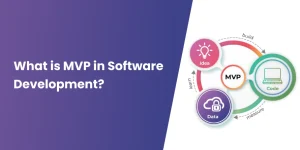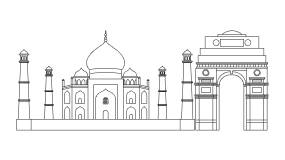How Much Does Custom Software Development Cost?

So, you’re considering developing a custom software solution, right? And you want to know how much it costs?
As a top custom software development service provider with years of experience, this is the one question we hear time and time again in our initial meetings. Whether you’re a business owner or an entrepreneur, we understand why this question is crucial.
However, even as industry experts, we know that providing an exact cost upfront can be challenging. The reason? Custom software development costs depend on several key factors that must be carefully considered.
It includes your specific software requirements, the industry niche you’re targeting, the technology stack you choose, and the platforms you want your software to run on, etc. (Web applications and mobile applications are most popular nowadays). The features and functionalities you wish to include will also play a significant role in determining the final cost.
In this blog, we’ll dive into these factors in detail, giving you a clearer understanding of what goes into the pricing of custom software development. But first, let’s explore the average costs you might expect for such a project.
Contact Us and Let’s Discuss to Understand Your Project Needs.
What Are the Prices for Custom Software Development?
The average cost of custom software development ranges between $70,000 to $250,000. However, it depends on the industry and the specific requirements of your project needs. Understanding what is custom software would give you an overview of the functions you require and which is most suitable for your development.
However, according to different industries, custom software solutions have unique needs, complexity, and features. Let’s find out the average cost of the software with their niche-specific requirements.
Here are the custom software development costs according to the industry.
- Retail and Ecommerce Software – $50,000 to $200,000
- On-Demand Software – $70,000 to $250,000
- Entertainment and Media Software – $80,000 and $300,000
- Education and Training Software – $60,000 to $180,000
- Real Estate and Property Software – $50,000 to $150,000
- Travel and Hospitality Software – $70,000 and $200,000
- Healthcare and Wellness Software Solution – $100,000 to $500,000
- Manufacturing Software Solution – $80,000 and $250,000
Now let’s move on to the factors that affect the custom software price.
Discover Your Custom Software Development Cost Today!
If your business is not in the above category of industry, then reach out to us to
learn about your custom software development cost.
Key Factors to Consider for Estimating Custom Software Development Cost
We understand that every project has a different aspect and uniqueness. Developing custom software requires considering several key factors that will help you estimate your project requirements. This will help you make informed decisions and ensure your investment aligns with your business goals.

1) Software Type You Choose
Each of the software types comes with its own set of requirements and challenges. Certain types of software meet your requirements.
1. Web Applications
Web applications are designed to run on web browsers and can be accessed from any device with an internet connection. Developing web application software is less expensive than mobile or desktop applications because they often have a single codebase and do not require platform-specific development.
2. Mobile Applications
Mobile apps are built on specific platforms such as iOS or Android. Also, if you need a mobile app that runs on both platforms, you’ll either need to develop two separate native apps or opt for cross-platform development, which a leading mobile app development company can help you execute efficiently.
3. Desktop Applications
Desktop applications are software solutions that run directly on a user’s computer. These applications are more complex to develop because they need to be compatible with various operating systems like Windows, macOS, or Linux.
4. Enterprise Software Solutions
Enterprise software solutions are large-scale applications designed to serve the needs of an entire organization. These include ERP systems, CRM software, and supply chain management tools. It requires integration with various other systems and databases within a company.
The cost for enterprise software solutions is high due to the need for security measures, extensive customization, and the capacity to handle large volumes of data and users.
5. SaaS (Software as a Service) Applications
SaaS applications are cloud-based software solutions that users access through a subscription model. It is complex to develop a SaaS application because it requires scalable architecture, multi-tenancy support, and continuous maintenance.
Many businesses also explore white label software development for SaaS, allowing them to rebrand and resell ready-made solutions without the need for extensive in-house development.
Also Read: SaaS Market Size Worldwide (To get better understanding of Market)
6. Embedded Software
Embedded software is designed to operate within a larger hardware system. It includes the software in an intelligent appliance or industrial machine. This type of software requires specialized development skills and close collaboration with hardware developers.
The type of software you choose to develop will set the foundation for your project’s budget. It’s essential to align your software needs with your business goals and available budget.
2) Software Complexity and Size
The complexity and size of the software you want to build significantly impact how challenging it is to develop, integrate, and maintain. Larger and more complex software often requires more development time, advanced technologies, and larger teams, which naturally leads to higher costs.
Complexity refers to the technical challenges and number of features, while size refers to the scale of functionalities, user base, or data volume your software needs to handle.
1. Simple Software Solutions
Simple software solutions are usually created for simple tasks and have essential features with limited functions. They are typically small in size and take less time and resources to create. So, ultimately, this reduces the cost of development. Simple software projects often need little customization and basic UI/UX design and do not involve complicated backend development.
2. Moderate Complexity Software
Moderate complexity software has more features and requires some level of customization. This can include applications with user login, data storage and retrieval, or websites that support online shopping. These project sizes need a longer development time involving custom designs, API connections, and advanced backend systems.
3. Complex Software Solutions
Complex software solutions have many detailed features, require extensive connections, and allow for much customization. This includes large business applications, big e-commerce sites, and software that needs to process data in real-time, use complex algorithms, or incorporate AI. Creating such software typically requires a team with various skills and more time, increasing costs.
4. Highly Complex or Innovative Software
Developing highly complex software pushes the boundaries of technology, including AI-powered platforms, blockchain solutions, and software that connects with IoT devices.
Due to their size and complexity, they require thorough research, advanced coding, and careful testing and adjustments. The pricing of such complex software based on the project’s size and creativity.
| Complexity of Software | Cost for Implementation |
|---|---|
| Simple Software Solutions | $10,000 to $50,000 |
| Moderate Complexity Software | $50,000 to $150,000 |
| Complex Software Solutions | $150,000 to $500,000 |
| Highly Complex or Innovative Software | $300,000 to $1,000,000 |
Are You Looking to Develop Software Using AI Technology?
Unlock the power of AI in your software. Partner with us today for
cutting-edge development solutions!
3) The Technology Stack You Choose
Choosing the right technology stack is one of the most crucial decisions to keep up with custom software development trends. The technology stack combines programming languages, frameworks, libraries, and tools you use to create your software.
Selection of the right tech stack can affect how well your software performs, how easily it can grow, and how simple it is to maintain. Let’s explore how different technology stack choices can affect your budget.
1. Front End Development Technologies
The front end, also known as the client side, is what users see and use. Common frontend technologies are HTML, CSS, JavaScript, and frameworks like React, Angular, and Vue.js.
Basic Frontend: The cost will be quite low if your software needs a basic, static frontend with simple technologies like HTML, CSS, and a little JavaScript.
Advanced Frontend Frameworks: To create more engaging and dynamic user interfaces, using advanced frameworks such as React or Angular can increase costs because they require more skill and complexity. It is based on how much customization and interactivity is needed.
2. Backend Development Technologies
The backend, also known as the server side, manages the logic, connects to the database, and ensures your software works properly. Popular backend languages and frameworks are Node.js, Python with Django, Ruby on Rails, Java, and . NET.
Simple Backend: For straightforward applications that need basic database connections and little logic, cost could be lower.
Advanced Backend: If your software requires complicated logic, real-time data handling, or connections with various services, the costs can increase greatly. Developing an advanced backend with technologies such as Node.js, Python, or Java can cost higher, based on how complex and efficient it needs to be.
3. Databases and Storage Solutions
You can choose from SQL databases such as MySQL or PostgreSQL or NoSQL databases like MongoDB or Cassandra.
If your application needs a distributed database, real-time data syncing, or must manage large amounts of unstructured data, then expenses can increase.
4. Third-Party Integrations
Custom software must often work with outside services like payment systems, analytics tools, or cloud platforms.
Integrating third-party services like payment gateways and basic analytics tools and building custom APIs can increase the cost of software development.
5. DevOps and Cloud Services
The choices in infrastructure and DevOps, like cloud hosting, CI/CD pipelines, and containerization with tools like Docker or Kubernetes, can impact costs.
Cost can vary from hosting your application on a simple cloud service with minimal DevOps to scalable cloud infrastructure, and an automated deployment pipeline could add more cost.
6. Cross-Platform vs. Native Development
If your software has to work on different platforms, like iOS and Android, for mobile apps, you must choose between cross-platform development with tools like Flutter or React Native or creating separate native apps for each platform.
Also Check: Flutter vs React Native: Which is the Best Cross-Platform Framework?
Depending on the complexity of the software, developing custom software for multiple platforms can save money.
| Technology Stack | Cost of Choosing Tech Stack |
|---|---|
| Front End Development Technologies | $5,000 to $20,000 |
| Backend Development Technologies | $10,000 to $100,000 |
| Databases and Storage Solutions | $10,000 to $60,000 |
| Third-Party Integrations | $5,000 to $30,000 |
| DevOps and Cloud Services | $10,000 to $40,000 |
| Cross-Platform vs. Native Development | $50,000 to $150,000 |
4) Designing Your Software
Designing your software is a step that shapes the user experience and the overall appeal of your software. The design phase primarily focuses on User Interface (UI) and User Experience (UX). These elements are crucial for ensuring your software works well, is easy to use, and is visually appealing.
However, the complexity directly influences the cost of your software’s design. The cost will be lower if you require a simple design with basic navigation and minimal visual elements.
Some of the software, such as enterprise-level software, requires complex architecture, and the UI/UX becomes a crucial part of it. So, the cost of software that needs a highly customized, user-centric design with advanced features like animations, custom icons, and interactive elements becomes higher.
Also, the cost of designing your software will depend upon the UI/UX designer. The experienced level designer will cost more compared to the junior level designer. But if you have a software solution that has a complex design, you might go for the experienced designer. Partnering with the best UI/UX design company would help you create the best software solution that fits your needs.
5) Development Team Size
The size of your development team greatly affects the total cost of your custom software project.
The number and type of team members can change based on the software’s complexity and size. Here’s a breakdown of typical team roles, average expenses, and estimated work hours.
| Position | Working Hours (Per Month) | Average Cost (Per Hour) |
|---|---|---|
| Project Manager | 160-200 hours | $50 to $150 |
| UI/UX Designer | 120-160 hours | $40 to $120 |
| Software Developers | 160-200 hours | $40 to $150 |
| QA Tester | 120-160 hours | $30 to $100 |
| DevOps Engineer | 140-180 hours | $60 to $150 |
Choose Different Types of Teams According to Your Needs
1. Small Development Teams
A small team works best for smaller projects or MVPs (Minimum Viable Products) with a limited scope and shorter timelines. These teams can be more flexible and allow better collaboration among team members and stakeholders.
2. Mid-Sized Development Teams
This team size is suitable for medium to large projects with some complexity. It needs specialized skills and a wider range of knowledge. Mid-sized teams can manage larger features and keep the workload balanced.
3. Large Development Teams
Big teams are ideal for complicated, large-scale projects that require many features, integrations, and custom changes. They can tackle different parts of the project at the same time, which speeds up development.
Choosing the right team size and developers means balancing your project needs and what you can afford. Understanding the cost to hire a software developer is essential to making the best decision for your budget.
As the best custom software development company, we can say that bigger teams can speed up work and tackle more challenging jobs, while smaller teams can provide more personal attention and save you money.
Find the Best Custom Software Development Company
Explore custom software solutions tailored to your business needs. Let’s create
something extraordinary together. Get started now!
6) Urgency of Project: Speed Comes at a Cost
When your project needs to be completed quickly, it often requires an extra price. The urgency comes at a cost. Speeding up development usually means bringing in more resources and developers and paying for additional hours, which drives up costs.
Faster Timelines: Speeding up a project usually raises costs by 20-50% because it requires more developers or longer hours.
Cost Effect: If a project starts with an estimated $100,000, speeding up the timeline might raise the cost to $120,000 or even $150,000.
Remember, urgency can get your software to market faster, but it’s essential to balance the costs against the potential benefits of launching sooner.
7) Integration With Other Systems
Integrating your custom software with current systems or third-party apps is essential for smooth operation. Whether linking to a CRM, ERP, or other platforms, integration helps all areas of your business work together effectively.
Importance of Integration: If integration is not done well, you may face data silos, inefficiencies, and the need for manual fixes, which can hinder your business processes. Good integration makes operations smoother and enhances overall performance.
Choose the right development team to integrate your custom software solution easily without breaking your business process.
Putting money into good integration can help you avoid higher costs and problems later.
8) Who is Developing Your Custom Software Solution?
The choice of who develops your custom software is crucial for the quality and cost of your project. Partnering with a trusted custom software development company like Guru TechnoLabs guarantees that your software is created with top quality, expertise, and dependability throughout the development process.
An experienced development team has many years of practice, which helps lower the chances of mistakes and hold-ups. Guru TechnoLabs, with its wide range of past projects, guarantees that your project is well taken care of.
Working with a leading company can help you to build a cost effective software solution based on how complex your project is. Although this might look like a significant expense, the quality and efficiency you receive make it a valuable choice.
Reducing the size of the development team may save money at first, but it can cause bigger problems and higher costs later on. Choosing a partner like Guru TechnoLabs means your software will be robust, adaptable, and designed for the future.
Each of the above factors significantly affects the final price, so knowing them can help you make intelligent choices and get the best return on your investment. Now, let’s look at some hidden factors that can vary depending on your project requirements.
Partner With Guru TechnoLabs for Custom Software Development
Transform your vision into reality for bespoke software development
solutions. Contact us today to get started!
Hidden Custom Software Development Costs
It is always important to consider future costs when planning a budget for custom software development. Some hidden costs when developing custom software need to be considered.
1. Maintenance and Support
Continuous maintenance and support are essential for your software to function well after it is launched. This involves correcting errors, adding new features, and ensuring it works with new systems.
Cost Impact: Maintenance usually costs about 15-20% of the original development cost annually. If a project costs $100,000, plan to spend an extra $15,000 to $20,000 annually for maintenance and support.
Regular updates and support can help avoid expensive problems and ensure your software remains safe and works well.
2. Development Methodology
Different custom software development services choose different approaches to developing the custom software. Whether Agile, Waterfall, DevOps, or Lean. It can affect both cost and efficiency.
Cost Impact: Agile methods usually require more money at the start because of ongoing changes and updates, but they can produce better results. Waterfall methods may cost less initially, but if changes are necessary later, they can become more expensive. The costs can differ between methods, with Agile potentially increasing the development budget by 10-15%.
Select a software development method that matches your project’s complexity and your team’s skills to keep things running smoothly and manage costs effectively.
3. Location of the Development Team
The location of your development team can greatly affect costs. Teams based offshore or nearby usually have lower rates than those based in your country, but they also bring unique challenges.
Cost Effect: Onshore development teams usually charge between $100 and $200 per hour, whereas offshore teams can cost between $30 and $100 per hour. Using an offshore team for a project could lead to savings of 30-50% on development expenses, but it may also require more effort in communication and management.
Cost savings are appealing, but make sure that time zone differences and communication issues are easy to handle to prevent delays in the project.
Knowing these hidden costs allows you to budget better and prepare for future expenses, leading to a smoother and more affordable custom software development process.
Importance of Developing Custom Software Solution With Us
Empower your business with custom software solutions designed for your unique needs.
- Tailored Solutions: Custom software for your business.
- Scalable and Flexible: Solutions that grow with you.
- Dedicated Support: Expert team support.
Transform your business today—partner with us for your
custom software needs!
Wrapping Up
Knowing the cost of custom software development is vital for good budgeting for small businesses and startups. It is always a wise choice to go for a successful business plan. Precise requirements, selecting the right team, recognizing hidden costs, and using cost-saving methods all impact your project’s budget.
By taking a strategic approach and planning carefully, you can control costs and ensure a high-quality outcome. If you want to improve your processes or add new features, a well-thought-out plan will help you reach your goals without any financial surprises. If you need help, feel free to contact experts like Guru TechnoLabs. A successful project begins with good budgeting and a reliable partner.
Frequently Asked Questions
The cost of custom software development depends on many factors. It includes:
- The Software Type
- Software Complexity
- The Technology Stack
- Software Design Needs,
- The Size of the Development Team
- Urgency of Your Project
- Integration With Other Systems
- Development Team Location
Each factor plays a role in the total budget, so assessing them is essential for an accurate cost estimate.
Software development has various stages, like planning, design, development, testing, and deployment; each stage comes with its own costs. For example, careful planning and design can lower costs by reducing the need for changes later. Development and testing usually take up most of the budget. Good management of each stage helps keep the budget in check and reduces surprise costs.
Small businesses usually spend between $50,000 and $150,000 to create custom software. This cost can change depending on the type of software, its features, and how complex it is. It's crucial for small businesses to clearly outline what they need and look for affordable options that fit their budget.
Custom software development usually uses a few pricing models: fixed price, time and materials, or dedicated team. The fixed price model works best for projects with clear goals, while time and materials allow for changes as the project develops. The dedicated team model offers continuous support and development for a set hourly or monthly fee, making it great for long-term projects.
The difficulty of software affects how much it costs to develop. Complex software, with many features and custom functions, takes more time and resources, leading to costs between $100,000 and $500,000. On the other hand, more straightforward projects with essential features and fewer integrations usually cost less, often between $50,000 and $100,000.
Custom software development usually costs more than ready-made solutions, priced between $10,000 and $50,000. Custom solutions, on average, range from $70,000 to $250,000. They are designed specifically for your business needs, providing a better match for your requirements and offering more value and efficiency in the long run.
Managing custom software cost requires a strategic approach. Here are some proven tips:
- Define your project scope clearly: Knowing exactly what you need helps avoid unnecessary changes and costs down the line.
- Break down project requirements: Breaking features into smaller tasks helps with accurate budgeting and progress tracking.
- Use project management tools: Tools like Jira, Trello, or Asana can keep the development process organized and transparent.
- Consider a fixed-price model (if appropriate): For well-defined projects, this can help control spending.
- Explore outsourcing options: Working with offshore or nearshore teams can reduce labor costs without sacrificing quality.
- Start with a Minimum Viable Product (MVP): Building an MVP lets you launch quickly, test the market, and scale later, which keeps early costs low.
These steps can help keep your custom software development budget under control and aligned with your business goals.
Project size is a key factor in custom software development pricing. Larger projects involve more features, users, data handling, and integrations, which increases complexity and cost. Here’s a general cost breakdown by project size:
Small/MVP Applications: $20,000 – $100,000
Ideal for startups or businesses needing core features to test a product idea.
Medium-Sized Applications: $100,000 – $500,000
These include more features, third-party integrations, and custom workflows, common in growing businesses.
Enterprise Solutions: $500,000 – $1,000,000+
Large-scale platforms with high user volume, complex systems, and advanced security needs, typical in enterprise environments.
Understanding the scale of your software helps in setting realistic budgets and timelines for development.




















